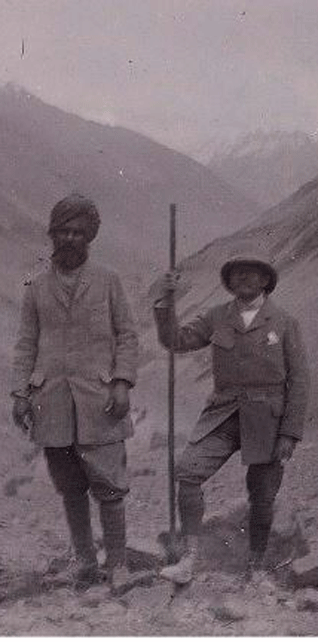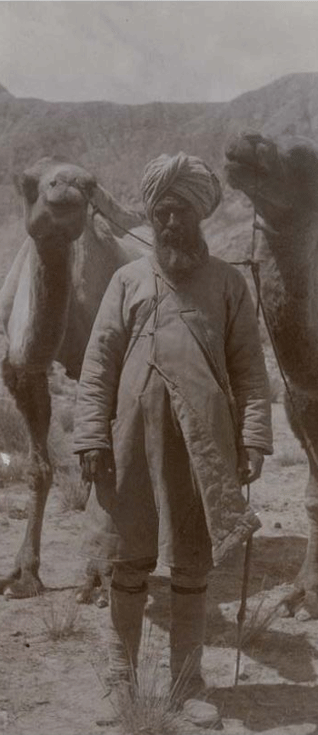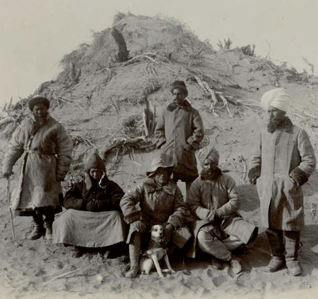Travel
Rai Bahadar Lal Singh:
Cartographer
Article & Photos by AMARDEEP SINGH
At a time when the “Great Game” was being played in Central Asia between the political powers of Britain, France and Russia, it was Sir Aurel Stein (1862 – 1943) a Hungarian adventurer who led an expedition into the Taklamakan desert (present day Xinjiang, Uyghur Autonomus Region of China).
Prior to this, it was believed that entry into Taklamakan was a one way road. Enter at your own risk and don’t expect to return.
Rai Bahadar Lal Singh (1860 – 1930), a Sikh cartographer accompanied Aurel Stein as his key confidant in the expedition set out to confirm the theories about the rich past of the Silk Road (connecting China with Central Asia).
Lal Singh’s motivation in this expedition was to map the remote Taklamakan territories.
The expedition was successful in discovering many Buddhist paintings and sculptures. Amongst these were the 100 wooden tablets from 105 BC, written in ancient script and bearing seals.
The most noteworthy discovery was of the “Caves of the Thousand Buddhas” at Dunhuamg. The artefacts were taken to the British Museum in England and later split across the museums in Britain, India and Hungary.
While the Chinese government views Aurel Stein’s expedition as a loot journey by a foreign devil robbing the history of Taklamakan region, one may argue that artefacts lying in museums across the world survived destruction at the time of Chinese cultural revolution.
Aurel Stein is recognized in photos clicked during the Taklamakan expedition, always with his dog, named Dash. In his team of explorers one would generally find two Sardars. One of them being Lal Singh, the other Ram Singh.
There can be no doubt of Sir Aurel Stein’s high regard for Lal Singh. There was clearly an appreciation of his professional and technical capabilities. Stein himself had studied cartography as part of his military training in Budapest, and liked to think in terms of ‘archaeological reconnaissance’.
But this was not the only thing the two had in common. They were roughly the same age (Lal Singh was born in 1860, Stein in 1862) and they seem to have shared an appreciation of certain human qualities: of independence, self-reliance, resilience and a respect for and understanding of the physical world around them. While it is clear that they enjoyed the company of others (and that others enjoyed their company), they also welcomed a certain amount of solitude away from others.
Stein took with him fond memories of working with Lal Singh, and it would seem that the sentiments were mutual.
On 11 August 1930, when Stein set out from Srinagar, he wrote in his notes: “Started from Macphersons at 3 p.m. down Chinar Bagh Canal, after farewell to dear old Lal Singh whose visits had been daily”.
During my extensive travel in Tibet, a drive over two weeks with my elder daughter (Tarni Kaur), from Lhasa to the remote western region of Indo-Tibet border at Guge Kingdom, many a time we wished we had more time to extend the drive via Kashgar and enter the Taklamakan desert, leading to Urumqi. We could not make it to Taklamkan but we did travel on a road at an elevation of 15,000 feet above sea level, close to the Sheeshapangma mountain, which could have led us to Kashgar and Urumqi.
Today, travel to remote areas of Taklamakan is made easy with the development of a high altitude road, but imagine the time Aurel Stein and Lal Singh travelled these areas on foot, accompanied with their Bactrian (double hump back) camels.
Taklamakan continues to call me and I patiently await the day I will be able to follow the footsteps of Rai Bahadar Lal Singh, reliving the life of this adventurous cartographer.
To see the complete photo gallery, please CLICK here.
Edited for sikhchic.com
January 7, 2013
Conversation about this article
1: Ravinder Singh (Los Angeles, California, USA), January 07, 2014, 3:47 PM.
As Sikhs we have an amazing history. So many explorers and entrepreneurs, it's incredible. As a community we must open our minds and expand Sikhi and our individual understanding of Sikhi beyond Punjab and our gurdwaras.






